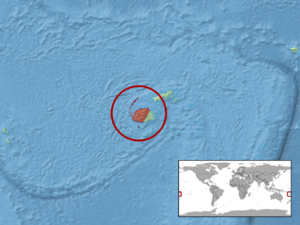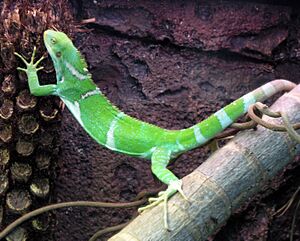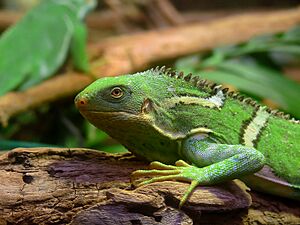Fiji crested iguana facts for kids
Quick facts for kids Fiji crested iguana |
|
|---|---|
 |
|
| In the Melbourne Zoo | |
| Conservation status | |
| Scientific classification | |
| Genus: |
Brachylophus
|
| Species: |
vitiensis
|
 |
|
The Fiji crested iguana (Brachylophus vitiensis) is a special type of iguana. It lives only on some islands in Fiji, a country in the Pacific Ocean. This iguana is found in dry forests on islands like Yaduataba, Yadua, and Monuriki. It is a critically endangered species, which means it is very close to disappearing forever.
Contents
How it was Discovered
The Fiji crested iguana was partly discovered thanks to a movie! The film The Blue Lagoon was shot on a remote island in Fiji. The movie showed some of the local animals, including a large, colorful iguana.
A scientist named Dr. John Gibbons had already found this iguana on another Fijian island. But when his friend saw the same iguana in the movie, they realized it lived in more places than they thought. Dr. Gibbons officially described this new species in 1981.
What's in a Name?
The scientific name for the Fiji crested iguana is Brachylophus vitiensis. The first part, Brachylophus, comes from two Greek words. "Brachys" means "short," and "lophos" means "crest" or "plume." This describes the short, spiky crest along the iguana's back.
The second part, vitiensis, is a Latin word that means "from Fiji." So, its name basically means "short-crested animal from Fiji."
The Fiji crested iguana is related to other iguanas in Fiji, like the Lau banded iguana and the Fiji banded iguana. Scientists believe these Pacific iguanas traveled a very long way. They likely floated about 9,000 kilometers (5,600 miles) across the Pacific Ocean from the Americas. Their closest relatives are still found there.
Where They Live

Fiji crested iguanas live only on certain islands in Fiji. They need a special kind of home called tropical dry forests. These forests are very rare and are one of the most endangered types of plants in the Pacific.
Most of these iguanas, fewer than 4,000, live on an island called Yadua Taba. This island is a protected area, so it's the only place where the iguanas are legally safe. The island is now free from forest fires and goats, which used to harm the iguanas.
A very small group of fewer than 80 iguanas lives on Macuata island. There are also a few on other islands like Monuriki and Malolo Levu. On Malolo Levu, a small protected forest was made for the last few iguanas there. Baby iguanas have been seen, which is good news!
These iguanas used to live higher up in the mountains, but now they are mostly found closer to sea level.
What They Look Like
The Fiji crested iguana is a large, strong lizard. It can grow up to 75 centimeters (30 inches) long and weigh about 300 grams (0.66 pounds).
Males have three thin, cream or white stripes on their bodies. These stripes often have black scales near them. The iguana also has a tall, spiky "crest" on its back. These spines can be as long as 1.5 centimeters (0.6 inches). They run from the back of its neck all the way to its tail.
When baby Fiji crested iguanas first hatch, they are dark green. But after a few hours, their skin turns bright emerald green. Then, you can see their narrow white stripes. Their eyes are usually reddish-orange or pinkish-gold.

How They Behave
Fiji crested iguanas are active during the day. They like to stay in the shade of trees. But on cooler days, they will look for sunlight to warm up.
These iguanas can change their color very quickly from green to black when they are scared or upset. They use this trick to scare away predators. The color changes depending on how much danger they feel. Bright green is normal, dark green means a little danger, and black means extreme danger.
If changing color doesn't work, they will puff up their neck and bob their head. They might even lunge towards the threat. To move between trees, they use overlapping branches. Their long toes and tails help them keep their balance as they climb.
What They Eat
Fiji crested iguanas mostly eat plants. They munch on leaves, fruits, shoots, and flowers from trees and bushes. They especially love the sweet hibiscus flowers from the Vau tree. The Vau tree is one of the places they spend most of their time.
Scientists have seen baby iguanas eat insects, but adult iguanas do not. Their diet doesn't change much with the seasons or between males and females.
How They Reproduce
Like all other iguanas, Fiji crested iguanas lay eggs. The breeding season starts in January with courtship and mating. The actual egg-laying happens between March and April.
They lay large, white eggs that feel leathery. Females dig holes on the forest floor to lay their eggs. They usually lay three to five eggs in a nest and then cover them up.
The eggs take a very long time to hatch, sometimes up to nine months! This is one of the longest incubation periods for any reptile. The babies usually hatch in October or November, at the start of the wet season. A few weeks before hatching, a brown oval mark appears on the egg. This mark shows where the baby iguana's head will pop out. After hatching, the baby iguanas drink water by licking wet leaves.
Iguanas and People
Folklore
In Fiji, the iguana is called vokai, or sometimes saumuri by certain tribes. Some tribes see the iguana as their special animal or "totem." Because of this, they are not allowed to say its name when women are around.
However, most Fijians are actually scared of the crested iguana. This is because of how it acts when it feels threatened.
Threats to the Iguana
The biggest danger to the Fiji crested iguana is losing its home. This happens because of fires, big storms, and land being cleared for farming. Another problem is competition from wild goats. Goats were brought to Yadua Taba island in 1972. They ate a lot of the plants and caused fires, which harmed the iguanas' forest.
After the iguanas were discovered, Yadua Taba became a protected area. Most of the goats were removed, and fires were banned. Now, the dry forest on the island is growing back and is a great example of a healthy Pacific dry forest.
Another threat is invasive Leucaena trees. These trees stop native food trees from growing for the iguanas. The Fijian government is working to remove them.
Other dangers come from animals that were brought to the islands, like rats, mongooses, and cats. These animals hunt the iguanas and eat their eggs. People have also hunted the iguanas for food or to sell them illegally as pets.
In 2002, some Fiji crested iguanas were stolen from the protected area. Luckily, customs officers caught the smuggler. Because of this, tourists are no longer allowed to visit the sanctuary. Only scientists can go there.
Protecting the Iguana
Many efforts are being made to save the Fiji crested iguana. Since the goats were removed from Yadua Taba, the forest has grown by 10-20% since 1980. This means more food and space for the iguanas.
Scientists recommend more actions to help them survive. One big step is to remove other introduced predators like cats, rats, and mongooses. This would be similar to how the goats were removed.
Also, Yadua Taba is the only island that is closely watched. People are asking for other islands where iguanas live, like Macuata, Monu, and Monuriki, to be monitored too. Another important action is planting more trees. More trees mean more food sources for the iguanas, which can help their population grow.
However, there isn't a lot of information about why the iguana population dropped so much. Without more detailed facts, it's harder to create the best plan to save them.



